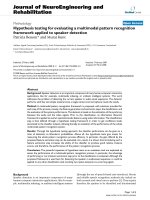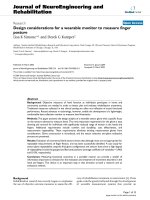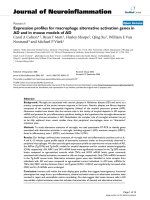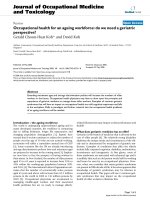Báo cáo hóa học: " Homoclinic solutions for second order discrete pLaplacian systems" pdf
Bạn đang xem bản rút gọn của tài liệu. Xem và tải ngay bản đầy đủ của tài liệu tại đây (346.98 KB, 16 trang )
RESEARC H Open Access
Homoclinic solutions for second order discrete p-
Laplacian systems
Xiaofei He
1,2*
and Peng Chen
2,3
* Correspondence: hxfcsu@sina.
com
1
Department of Mathematics and
Computer Science Jishou
University, Jishou, Hunan 416000, P.
R. China
Full list of author information is
available at the end of the article
Abstract
Some new existence theorems for homoclinic solutions are obtained for a class of
second-order discrete p-Laplacian systems by critical point theory, a homoclinic orbit
is obtained as a limit of 2kT-periodic solutions of a certain sequence of the second-
order difference systems. A completely new and effective way is provided for dealing
with the existence of solutions for discrete p-Laplacian systems, which is different
from the previous study and generalize the results.
2010 Mathematics Subject Classification: 34C37; 58E05; 70H05.
Keywords: homoclinic solutions, discrete variational methods, p-Laplacian systems
1. Introduction
In this article, we shall be concerned with the existence of homoclinic orbits for the
second-order discrete p-Laplacian systems:
(ϕ
p
(u(n −1))) = ∇F( n, u(n)) + f(n), n ∈ Z, u ∈ R
N
,
(1:1)
where p >1,
p
(s)=|s|
p-2
s is the Laplacian operator, Δu(n)=u(n +1)-u(n)isthe
forward difference operator, F : ℤ × ℝ
N
® ℝ is a continuous function in the second
variable and satisfies F(n + T, u)=F(n, u) for a given positive integer T.Asusual,N,
ℤ and ℝ denote the set of all natural numbers, integers and real numbers, respectivel y.
For a, b Î ℤ, denote ℤ(a)={a, a + 1, }, ℤ(a, b)={a, a + 1, b} when a ≤ b.
Differential equations occur widely in numeroussettingsandformsbothinmathe-
matics itself and in its application to statistics, computing, electrical circuit analysis,
biology and other fields, so it is worthwhile to explore this topic. As is known to us,
the development of the study of periodic solution and their connecting orbits of differ-
ential equations is relativel y rapid. Many excellent results were obtained by variational
methods [1-11]. It is well-known that homoclinic orbits play an important role in ana-
lyzing the chaos of dynamical systems. If a system has the transversely intersected
homoclinic orbits, then it must be chaotic. If it has the smoothly connected homoclinic
orbits, then it cannot stand the perturbation, its perturbed system probably produce
chaotic phenomenon.
On the other hand, we know that a differential equation model is often derived from
a difference equation, and numerical solutions of a different ial equation have to be
obtained by discretizing the differential equation, therefore, the study of periodic solu-
tion and connecting orbits of difference equation is meaningful [12-24].
He and Chen Advances in Difference Equations 2011, 2011:57
/>© 2011 He and Chen; licensee Springer. This is an Open Access article distributed under th e terms of the Creative Commons
Attribution License (http://creativecomm ons.org/licenses/by/2.0), which permits unrestricted use, distribution, and reproductio n in
any medium, provided the original work is prop erly cited.
It is clear that system (1.1) is a discretization of the following second differential sys-
tem
d
dt
(|
˙
u(t ) |
p−2
˙
u(t )) = ∇F(t, u(t)) + f (t), t ∈
R, u ∈ R
N
.
(1:2)
Recently, the following second order self-adjoint difference equation
[p(n)u(n −1)] + q(n)u(n)=f (n, u(n)), n ∈ Z, u ∈ R
(1:3)
has been studied by using variational method. Yu and Guo e stablish ed the existence
of a periodic solution for Equation (1.3) by applying the critical point theory in [15].
Ma and Guo [20] obtained homoclinic orbits as the limit of the subharmonics for
Equation (1.3) by applying the Mountain Pass theorem relying on Ekelands variational
principle and the diagonal method, their results are based on scalar equation with q(t)
≠ 0, if q(t) = 0, the traditional ways in [20] are inapplicable to our case.
Some special cases of (1.1) have been studied by many researchers via variational
methods [15-17,22,23]. However, to our best knowledge, results on homoclinic solu-
tions for system (1.1) have not been studied. Motivated by [9,10,20], the main purpose
of this article is to give some sufficient conditions for the existence of homoclinic solu-
tions to system (1.1).
Our main results are the following theorems.
Theorem 1.1 Assume that F and f satisfy the following conditions:
(H1) F(n, x) is T-periodic with respect to n,T >0and continuously differentiable in x;
(H2) There are constants b
1
>0and ν >1such that for all (n, x) Î ℤ × ℝ
N
,
F( n, x) ≥ F(n,0)+b
1
|x|
ν
;
(H3) f ≠ 0 is a bounded function such that
n∈Z
|f (n)|
ν/(ν−1)
< ∞
.
Then, system (1.1) possesses a homoclinic solution.
Theorem 1.2 Assume that F and f satisfy the following conditions:
(H4) F(n, x)=K(n, x)-W(n, x), where K, W is T-periodic with respect to n,T >0,K
(n, x) and W ( n, x) are continuously differentiable in x;
(H5) There is a constant μ >p such that for every n Î ℤ, u Î ℝ
N
\{0},
0 <μW(n, x) ≤ (∇W(n, x), x);
(H6) ∇W(n,x)=o(| x|), as |x| ® 0 uniformly with respect to n;
(H7) There exist constants b
2
>0and g Î (1, p] such that for all (n, u) Î ℤ × ℝ
N
,
K(n,0)=0, K(n, x) ≥ b
2
|x|
γ
;
(H8) There is a constant
∈ [p, μ)
such that
(x, ∇K(n, x)) ≤ K(n, x), ∀(n, x) ∈ [0, T] × R
N
;
(H9) f ≠ 0 is a bounded function such that
n∈Z
|f (n)|
q
<
min
δ
p−1
p
, b
2
δ
γ −1
− M
1
δ
μ−1
q
C
p
,
He and Chen Advances in Difference Equations 2011, 2011:57
/>Page 2 of 16
where
1
p
+
1
q
=1
and
M
1
=sup{W(n, x)|n ∈ [0, T], x ∈ R
N
, |x| =1},
C is given in (3.4) and δ Î (0,1] such that
b
2
δ
γ −1
− M
1
δ
μ−1
=max
x∈[0,1]
b
2
x
γ −1
− M
1
x
μ−1
.
Then, system (1.1) possesses a nontrivial homoclinic solution.
Remark Obviously, condition (H9) holds naturally when f =0.Moreover,ifb
2
(g -1)
≤ M (μ - 1), then
δ =
b
2
(γ − 1)
M(μ − 1)
1/(μ−γ )
,
and so condition (H9) can be rewritten as
n∈Z
|f ( n)|
q
<
min
1
p
b
2
(γ − 1)
M(μ − 1)
(p−1)/(μ−γ )
,
b
2
(μ − γ )
μ − 1
b
2
(γ − 1)
M(μ − 1)
(γ −1)/(μ−γ )
q
C
p
,
if b
2
(g -1)>M(μ - 1), then δ = 1 and b
2
δ
(g -1)
- Mδ
(μ -1)
= b
2
- M, and so condition
(H9) can be rewritten as
n∈Z
|f (n)|
q
< C
−p
(min{p
−1
, b
2
− M})
q
.
(1:4)
2. Preliminaries
In this section, we recall some basic facts which will be used in the proofs of our main
results. In order to apply the critical point theory, we make a variational structure.
Let S be the vector space of all real sequences of the form
u = {u(n)}
n∈Z
=( , u(−n), u(−n +1), , u(−1), u(0), u(1), , u(n), ),
namely
S = {u = {u( n)} : u(n) ∈ R
N
, n ∈ Z}.
For each k Î N,letE
k
denote the Banach space of 2kT-periodic functions on ℤ with
values in ℝ
N
under the norm
||u||
E
k
:=
⎡
⎣
kT−1
n=−kT
(|u(n −1)|
p
+ |u(n)|
p
)
⎤
⎦
1/p
.
In order to receive a homoclinic solution of (1.1), we consider a sequence of systems:
(ϕ
p
(u(n − 1))) + ∇F(n, u(n)) = f
k
(n), n ∈ Z, u ∈ R
N
,
(2:1)
where f
k
: ℤ ® ℝ
N
is a 2kT-periodic extension of restriction of f to the interval [-kT,
kT -1], k Î N. Similar to [20], we will prove the existence of one homoclinic solution
of (1.1) as the limit of the 2kT-periodic solutions of (2.1).
He and Chen Advances in Difference Equations 2011, 2011:57
/>Page 3 of 16
For each k Î N,let
l
p
2kT
(Z, R
N
)
denote the Banach space of 2kT-periodic functions
on ℤ with values in ℝ
N
under the norm
||u||
l
p
2kT
=
⎛
⎝
n∈N[−kT, kT−1]
|u(n)|
p
⎞
⎠
1
p
, u ∈ l
p
2kT
.
Moreover,
l
∞
2kT
denote the space of all bounded real functions on the interval N[-kT,
kT - 1] endowed with the norm
||u||
l
∞
2kT
=max
n∈N[−kT, kT−1]
{|u(n)|}, u ∈ l
∞
2kT
.
Let
I
k
(u)=
kT−1
n=−kT
1
p
|u(n − 1)|
p
+ F(n, u(n)) + (f
k
(n), u(n))
.
(2:2)
Then I
k
Î C
1
(E
k
,ℝ) and it is easy to check that
I
k
(u)v =
kT −1
n=−kT
[(|u(n − 1)|
p−2
u(n −1), v(n − 1)) + (∇F(n, u(n)), v(n)) + (f
k
(n), v
k
(n))].
Furthermore, the critical points of I
k
in E
k
are classical 2kT-periodic solutions of
(2.1).
That is, the functional I
k
is just the variational framework of (2.1).
In order to prove Theorem 1.2, we need the following preparations.
Let h
k
: E
k
® [0, +∞) be such that
ηk(u)=
⎛
⎝
kT−1
n=−kT
[|u(n −1)|
p
+ pK(n, u)]
⎞
⎠
1
p
.
(2:3)
Then it follows from (2.2), (2.3), (H4) and (H8) that
I
k
(u)=
1
p
η
p
k
(u)+
kT−1
n=−kT
[−W(n, u(n)) + (f
k
(n), u(n))],
(2:4)
and
I
k
(u)u ≤
kT−1
n=−kT
[|u(n −1)|
p
+ K(n, u(n))] −
kT−1
n=−kT
(∇W(n, u(n)), u(n)) +
kT−1
n=−kT
(f
k
(n), u(n))
(2:5)
We will obtain the critical points o f I by using the Mountain Pass Theorem. Since
the minimax characterisation provides the critical value, it is important for what fol-
lows. Therefore, we state these theorems precisely.
Lemma 2.1 [7]Let E be a real Banach space and I Î C
1
(E,ℝ) satisfy (PS)-condition.
Suppose that I satisfies the following conditions:
(i) I(0) = 0;
(ii) There exist constants r, a >0such that
I|
∂B
p
(0)
≥ α
;
He and Chen Advances in Difference Equations 2011, 2011:57
/>Page 4 of 16
(iii) There exists
e ∈ E\
¯
B
ρ
(0)
such that I(e)<0.
Then I possesses a critical value c ≥ a given by
c =inf
g∈
max
s∈[0,1]
I(g(s)),
where B
r
(0) is an open ball in E of radius r centered at 0, and
= {g ∈ C([0, 1], E} : g(0) = 0, g(1) = e}.
Lemma 2.2 [4]Let E be a Banach space, I : E ® ℝ a functional bounded from below
and differentiable on E. If I satisfies the (PS)-condition then I has a minimum on E.
Lemma 2.3 [3]For every n Î ℤ, the following inequalities hold:
W(n, u) ≤ W
n,
u
|u|
|u|
μ
, if 0 < |u|≤1,
(2:6)
W(n, u) ≥ W
n,
u
|u|
|u|
μ
, ifquad|u|≥1.
(2:7)
Lemma 2.4 Set m := inf{W(n, u):n Î [0,T], |u| = 1}. Then for every ζ Î ℝ\{0}, u Î
E
k
\{0}, we have
kT−1
n=−kT
W(n, ζ u(n)) ≥ m|ζ |
μ
kT−1
n=−kT
|u(n)|
μ
− 2kTm.
(2:8)
Proof Fix ζ Î ℝ \{0} and u Î E
k
\{0}.
Set
A
k
= {n ∈ [−kT, kT − 1] : |ζ u(n)|≤1}, B
k
= {n ∈ [−kT, kT − 1] : |ζ u(n)|≥1}.
From (2.7), we have
kT
n=−kT
W(n, ζ u(n)) ≥
n∈B
k
W(n, ζ u(n)) ≥
n∈B
k
W
n,
ζ u(n)
|ζ u(n)|
|ζ u(n)|
μ
≥ m
n∈B
k
|ζ u(n)|
μ
≥ m
kT−1
n=−kT
|ζ u(n)|
μ
− m
n∈A
k
|ζ u(n)|
μ
≥ m|ζ |
μ
kT−1
n=−kT
|u(n)|
μ
− 2kTm.
3. Existence of subharmonic solutions
In this section, we prove the existence of subharmonic soluti ons. In order to establish
the condition of existence of subharmonic solutions for (2.1), first, we will prove the
following lemmas, based on which we can get results of Theorem 1.1 and Theorem
1.2.
Lemma 3.1 Let a, b Î ℤ, a, b ≥ 0 and u Î E
k
. Then for every n,t Î ℤ, the following
inequality holds:
He and Chen Advances in Difference Equations 2011, 2011:57
/>Page 5 of 16
|u(n)|≤(a + b +1)
−1/ν
n+b
t=n−a
|u(t)|
ν
1/ν
+
max{a +1,b}
(a + b +1)
1/p
n+b
t=n−a
|u(t − 1)|
p
1/p
.
(3:1)
Proof Fix n Î ℤ, for every τ Î ℤ,
|u(n)|≤|u(τ )|+
n
t=τ +1
u(t − 1)
,
(3:2)
then by (3.2) and Höder inequality, we obtain
(a + b +1)|u(n)|≤
n+b
τ =n−a
|u(τ )| +
n+b
τ =n−a
n
t=τ +1
|u(t − 1)|
≤
n+b
τ =n−a
|u(τ )| +
n
τ =n−a
n
t=n=a+1
|u(t −1)| +
n+b
τ =n+1
n+b
t=n+1
|u(t −1)|
≤ (a + b +1)
(ν−1)/ν
n+b
t=n−a
|u(t)|
ν
1/ν
+max{a +1,b}
n+b
t=n−a
|u(t − 1)|
≤ (a + b +1)
(ν−1)/ν
n+b
t=n−a
|u(t)|
ν
1/ν
+max{a +1,b}
n+b
t=n−a
(a + b +1)
(p−1)/p
n+b
t=n−a
|u(t −1)|
p
1/p
,
which implies that (3.1) holds. The proof is complete.
Corollary 3.1 Let u Î E
k
. Then for every n Î ℤ, the following inequality holds:
||u(n)||
l
∞
2kT
≤ T
−1/ν
⎛
⎝
kT−1
n=−kT
|u(n)|
ν
⎞
⎠
1/ν
+ T
(p−1)/p
⎛
⎝
kT−1
n=−kT
|u(n − 1)|
p
⎞
⎠
1/p
,
(3:3)
Proof For n Î [-kT, kT - 1], we can choose n* Î [-kT, kT - 1] such that u(n*) =
max
nÎ[-kT, kT-1]
|u(n)|. Let a Î [0,T) and b = T - a - 1 such that -kT ≤ n*-a ≤ n* ≤ n*
+ b ≤ kT - 1. Then by (3.1), we have
|u(n
∗
)|≤T
−1/ν
n
∗
+b
n=n
∗
−a
|u(n)|ν
1/ν
+ T
(p−1)/p
n
∗
+b
n=n
∗
−a
|u(n − 1)|
p
ds
1/p
≤ T
−1/ν
⎛
⎝
kT−1
n=−kT
|u(n)|ν
⎞
⎠
1/ν
+ T
(p−1)/p
⎛
⎝
kT−1
n=−kT
|u(n − 1)|p
⎞
⎠
1/p
,
which implies that (3.3) holds. The proof is complete.
Corollary 3.2 Let u Î E
k
. Then for every n Î ℤ, the following inequality holds:
||u(n)||
l
∞
2kT
≤ 2max{T
(p−1)/p
, T
−1
}||u||
E
k
˙=C||u||
E
k
.
(3:4)
Proof Let ν = p in (3.3), we have
||u(n)||
p
l
∞
2kT
≤ 2
p
⎛
⎝
T
−1
kT−1
n=−kT
|u(n)|
p
+ T
p−1
kT−1
n=−kT
|u(n − 1)|
p
⎞
⎠
≤ 2
p
max{T
p−1
, T
−p
}
⎛
⎝
kT−1
n=−kT
|u(n − 1)|
p
+ |u(n)|
p
⎞
⎠
=2
p
max{T
p−1
, T
−p
}||u||
p
E
k
,
He and Chen Advances in Difference Equations 2011, 2011:57
/>Page 6 of 16
which implies that (3.4) holds. The proof is complete.
For the sake of convenience, set
= min
δ
p−1
p
, b
2
δ
γ −1
− M
1
δ
μ−1
. By (H9), we have
n∈Z
|f (n)|
q
<
q
C
p
,
(3:5)
where C is given in (3.4).
Here and subsequently,
N(k
0
)˙={k : k ∈ N, k ≥ k
0
}.
Lemma 3.2 Assume that F and f satisfy (H1)-(H3). Then for every k Î N, system (2.1)
possesses a 2kT-periodic solution u
k
Î E
k
such that
1
p
kT−1
n=−kT
|u
k
(n − 1)|
p
+ b
1
kT−1
n=−kT
|u
k
|
ν
≤ M
⎛
⎝
kT−1
n=−kT
|u
k
|
ν
⎞
⎠
1/ν
,
(3:6)
where
M =
n∈Z
|f (n)|
ν/(ν−1)
(ν−1)/ν
.
(3:7)
Proof Set
C
0
=
T
n=0
F( n,0)
. By (H2), (H3), (2.2), and the Höder inequality, we have
I
k
(u)=
kT−1
n=−kT
1
p
|u(n − 1)|
p
+ F(n, u(n)) + (f
k
(n), u(n))
≥
kT−1
n=−kT
1
p
|u(n − 1)|
p
+ F(n,0)+b
1
|u(n)|
ν
+(f
k
(n), u(n))
=
1
p
kT−1
n=−kT
|u(n − 1)|
p
+ b
1
kT−1
n=−kT
|u(n)|
ν
+
kT−1
n=−kT
(f
k
(n), u(n)) + 2kC
0
≥
1
p
kT−1
n=−kT
|u(n − 1)|
p
+ b
1
kT−1
n=−kT
|u(n)|
ν
−
⎛
⎝
kT−1
n=−kT
|f
k
(n)
ν/(ν−1)
⎞
⎠
⎛
⎝
kT−1
n=−kT
|u(n)|
ν
⎞
⎠
1/ν
+2kC
0
≥
1
p
kT−1
n=−kT
|u(n − 1)|
p
+ b
1
kT−1
n=−kT
|u(n)|
ν
− M
⎛
⎝
kT−1
n=−kT
|u(n)|
ν
⎞
⎠
1/ν
+2kC
0
.
(3:8)
For any x Î [0, +∞), we have
b
1
2
x
ν
− Mx ≥−
b
1
2
(ν − 1)
2M
b
1
μ
ν/(ν−1)
:= −D.
He and Chen Advances in Difference Equations 2011, 2011:57
/>Page 7 of 16
It follows from (3.8) that
I
k
(u) ≥
1
p
kT−1
n=−kT
|u(n − 1)|
p
+
b
1
2
kT−1
n=−kT
|u(n)|
ν
− D +2kC
0
.
Consequently, I
k
is a functional bounded from below.
Set
¯
u =
1
2kT
kT−1
n=−kT
u(n), and
˜
u(n)=u(n)=
¯
u.
Then by Sobolev’s inequality, we have
||
˜
u||
l
∞
2kT
≤ C
1
||u(n − 1)||
l
p
2kT
,and||
˜
u||
l
p
2kT
≤ C
2
||u(n − 1)||
l
p
2kT
.
(3:9)
In view of (3.9), it is easy to verify, for each k Î N, that the following conditions are
equivalent:
(i)
||u||
E
k
→∞;
(ii)
|
¯
u|
p
+
kT−1
n=−kT
|u(n − 1)|
p
→∞;
(iii)
kT−1
n=−kT
|u(n −1)|
p
+
b
1
2
kT−1
n=−kT
|u(n)|
ν
→∞.
Hence, from (3.8), we obtain
I
k
(u) → +∞ as ||u||
E
k
→∞.
Then, it is easy to verify that I
k
satisfies (PS)-condition. Now by Lemma 2.2, we con-
clude that for every k Î N there exists u
k
Î E
k
such that
I
k
(u
k
)= inf
u∈E
k
I
k
(u).
Since
I
k
(0) =
kT−1
n=−kT
F( n,0) =2kC
0
,
we have I
k
(u
k
) ≤ 2kC
0
. It follows from (3.8) that
1
p
kT−1
n=−kT
|u(n − 1)|
p
+ b
1
kT−1
n=−kT
|u
k
|
ν
≤ M
⎛
⎝
kT−1
n=−kT
|u
k
(n)|
p
⎞
⎠
1/p
.
This shows that (3.6) holds. The proof is complete.
Lemma 3.3 Assume that all conditions of Theorem 1.2 are satisfied. Then for every k
Î N (k
0
), the system (2.1) possesses a 2kT-periodic solution u
k
Î E
k
.
Proof In our case it is clear that I
k
(0) = 0. First, we show that I
k
satisfies the (PS)
condition. Assume that {u
j
}
jÎN
in E
k
is a sequence such that {I
k
(u
j
)}
jÎN
is bounded and
I
k
(u
j
) → 0, j → +∞
. Then there exists a constant C
k
> 0 such that
|I
k
(u
j
)|≤C
k
, ||I
k
(u
j
)||
k
∗
≤ C
k
(3:10)
He and Chen Advances in Difference Equations 2011, 2011:57
/>Page 8 of 16
for every j Î N. We first prove that {u
j
}
jÎN
is bounded. By (2.3) and (H5), we have
η
p
k
(u
j
) ≤ pI
k
(u
j
)+
p
μ
kT−1
t=−kT
(∇W(n, u
j
(n)), u
j
(n)) − p
kT−1
n=−kT
(f
k
(n), u(n)),
(3:11)
From (2.5), (3.5), (3.10) and (3.11), we have
1 −
μ
η
p
k
(u
j
) ≤ pI
k
(u
j
) −
p
μ
I
k
(u
j
)u
j
−
p −
p
μ
kT−1
n=−kT
(f
k
(n), u(n))
≤ pC
k
+
⎡
⎢
⎣
p
μ
I
k
(u
j
)
k∗
+
p −
p
μ
⎛
⎝
kT−1
n=−kT
f
k
(n)
q
⎞
⎠
1/q
⎤
⎥
⎦
u
j
E
k
≤ pC
k
+
pC
k
μ
+
p(μ − 1)
C
p−1
μ
u
j
E
k
= pC
k
+ D
k
u
j
E
k
, k ∈ N(k
0
),
(3:12)
where
D
k
=
pC
k
μ
+
p(μ −1)
C
p−1
μ
.
Without loss of generality, we can assume that
||u
j
||
E
k
=0
. Then from (2.3), (3.3),
and (H7), we obtain for j Î N,
η
p
k
(u
j
)=
⎛
⎝
kT−1
n=−kT
[|u
j
(n − 1)|
p
+ pK(n, u
j
)]
⎞
⎠
≥
⎛
⎝
kT−1
n=−kT
[|u
j
(n − 1)|
p
+ pb
2
|u
j
(n)|γ ]
⎞
⎠
≥
⎛
⎝
kT−1
n=−kT
⎡
⎣
|u
j
(n − 1)|
p
+ pb
2
(C||u
j
(n)||
E
k
)
γ −p
kT−1
n=−kT
|u
j
(n)|
p
⎤
⎦
⎞
⎠
≥ min{1, pb
2
(C||u
j
(n)||
E
k
)
γ −p
}
⎛
⎝
kT−1
n=−kT
|u
j
(n − 1)|
p
+
kT−1
t=−kT
|u
j
(n)|p
⎞
⎠
= min{1, pb
2
(C||u
j
(n)||
E
k
)
γ −p
}||u
j
||
p
E
k
= min{||u
j
||
p
E
k
, pb
2
C
γ −p
||u
j
(n)||
γ
E
k
}
(3:13)
Combining (3.12) with (3.13), we have
min
u
j
p
E
k
, pb
2
C
γ −p
u
j
(n)
γ
E
k
≤
μ
μ −
(pC
k
+ D
k
u
j
E
k
)
(3:14)
It follows from (3.14) that {u
j
}
jÎN
is bounded in E
k
, it is easy to prove that {u
j
}
jÎN
has
a convergent subsequence in E
k
. Hence, I
k
satisfies the Palais-Smale condition.
We now show that there exist constants r, a > 0 independent of k such that I
k
satis-
fies assumption ( ii) of Lemma 2.1 with these constants. If
u
E
k
= δ/ C := |ρ
,thenit
follows from (3.4) that |u(n)| ≤ δ ≤ 1forn Î [-kT, kT - 1] and k Î N(k
0
). By Lemma
2.3 and (H9), we have
He and Chen Advances in Difference Equations 2011, 2011:57
/>Page 9 of 16
kT−1
n=−kT
W(n, u(n)) =
n∈[−kT,kT−1]|u(n)=0
W(n, u(n))
≤
n∈[−kT,kT−1]|u(n)=0
W
n,
u(n)
u(n)
u(n)
μ
≤ M
1
kT−1
n=−kT
u(n)
μ
≤ M
1
δ
μ−γ
kT−1
n=−kT
u(n)
γ
, k ∈ N(k
0
),
(3:15)
and
kT−1
n=−kT
|u(n)|
p
≤ δ
p−γ
kT−1
n=−kT
|u(n)|
γ
, k ∈ N(k
0
).
(3:16)
Set
α =
δ
C
1
C
p−1
min
δ
p−1
p
, b
2
δ
γ −1
− M
1
δ
μ−1
−
n∈Z
|f (n)|
q
.
(3:17)
Hence, from (2.1), (3.4) and (3.15)-(3.17), we have
I
k
(u)=
kT−1
n=−kT
1
p
|u(n − 1)|
p
+ K(n, u(n)) − W(n, u(n)) + (f
k
(n), u(n))
≥
1
p
kT−1
n=−kT
|u(n −1)|
p
+ b
2
kT−1
n=−kT
|u(n)|
γ
−
kT−1
n=−kT
W(n, u(n))+
kT−1
n=−kT
(f
k
(n), u(n))
≥
1
p
kT−1
n=−kT
|u(n −1)|
p
+(b
2
− M
1
δ
μ−γ
)
kT−1
n=−kT
|u(n)|
γ
−
⎛
⎝
kT−1
n=−kT
|f
k
(n)|
q
⎞
⎠
1/q
⎛
⎝
kT−1
n=−kT
|u(n)|
p
⎞
⎠
1/p
≥
1
p
kT−1
n=−kT
|u(n −1)|
p
+(b
2
− M
1
δ
μ−γ
)
kT−1
n=−kT
|u(n)|
γ
−
n∈Z
|f
k
(n)|
q
1/q
⎛
⎝
kT−1
n=−kT
|u(n)|
p
⎞
⎠
1/p
≥ min
1
p
, b
2
δ
γ −p
− M
1
δ
μ−p
⎛
⎝
kT−1
n=−kT
|u(n − 1)|
p
+
kT−1
n=−kT
|u(n)|
p
⎞
⎠
−
n∈Z
|f
k
(n)|
q
1/q
⎛
⎝
kT−1
n=−kT
|u(n − 1)|
p
+
kT−1
n=−kT
|u(n)|
p
⎞
⎠
1/p
= min
1
p
, b
2
δ
γ −p
− M
1
δ
μ−p
u
p
E
k
−u
E
k
n∈Z
|f
k
(n)|
q
1/q
=
δ
C
⎡
⎣
1
C
p−1
min
δ
p−1
p
, b
2
δ
γ −1
− M
1
δ
μ−1
−
n∈Z
|f
k
(n)|
q
1/q
⎤
⎦
= α, k ∈
N(k
0
).
(3:18)
(3.18) shows that
u
E
k
= ρ
implies that I
k
(u) ≥ a for k Î N(k
0
).
He and Chen Advances in Difference Equations 2011, 2011:57
/>Page 10 of 16
Finally, it remains to show that I
k
satisfies assumption (iii) of Lemma 2.1. Set
a
1
=max{K(n, x ) |n ∈ [0, T], x ∈ R
N
, |x| =1},
and
a
2
=max{K(n, x ) |n ∈ [0, T], x ∈ R
N
, |x|≤1},
Then by (H8) and 0 <a
1
≤ a
2
< ∞,
K(n, x) ≤ a
1
|x|
+ a
2
,for(n, x) ∈ Z ×R
N
.
(3:19)
By (2.2), (3.19) and Lemma 2.4, we have for every ζ Î ℝ \ {0} and u Î E
k
\ {0}
I
k
(ζ u)=
kT−1
n=−kT
1
p
|u(n − 1)|
p
+ K(n, ζ u(n)) − W(n, ζ u(n)) + ζ (f
k
(n), u(n))
≤
|ζ |
p
p
kT−1
n=−kT
|u(n − 1)|
p
+ a
1
|ζ |
kT−1
n=−kT
|u(n)|
− m|ζ |
μ
kT−1
n=−kT
|u(n)|
μ
+ |ζ |
n∈Z
|f
k
(n)|
q
1/q
u
E
k
+2kT(m + a
2
), k ∈ N(k
0
).
(3:20)
Take
Q ∈ E
k
0
such that Q(± k
0
T) = 0 and Q ≠ 0. Since
p ≤ <μ
and m > 0, (3.20)
implies that there exists ξ > 0 such that
ξ Q
E
k
0
>ρ
and
I
k
0
(ξQ) < 0
.Set
e
k
0
(n)=ξQ(n)
and
e
k
(n)=
e
k
0
(n), for
|
n
|
≤ k
0
T,
0, for k
0
T <
|
n
|
≥ kT.
(3:21)
Then
e
k
∈ E
k
,
e
k
E
k
=
e
k
0
E
k
0
>ρ
and
I
k
(e
k
)=I
k
0
(e
k
0
) < 0
for k Î N(k
0
). By
Lemma 2.1, I
k
possesses a critical value c
k
≥ a given by
c
k
=inf
g∈
k
max
s∈[0,1]
I
k
(g(s)), k ∈ N ( k
0
).
where
k
= {g ∈ C([0, 1], E
k
):g(0) = 0, g(1) = e
k
}, k ∈ N(k
0
).
Hence, for k Î N( k
0
), there exists u
k
Î E
k
such that
I
k
(u
k
)=c
k
,andI
k
(u
k
)=0.
Then function u
k
is a desired classical 2kT-periodic solution of (1.1) for k Î N(k
0
).
Since c
k
>0,u
k
is a nontrivial solution even if f
k
(n) = 0. The proof is complete.
4. Existence of homoclinic solutions
Lemma 4.1 Let u
k
Î E
k
be the solution of system (2.1) that satisfies (3.6) for k Î N.
Then there exists a positive constant d
1
independent of k such that
u
k
l
∞
2kT
≤ d
1
, k ∈ N.
He and Chen Advances in Difference Equations 2011, 2011:57
/>Page 11 of 16
Proof By (3.6), we have
b
1
kT−1
n=−kT
|u
k
(n)|
ν
≤ M
⎛
⎝
kT−1
n=−kT
|u
k
(n)|
ν
⎞
⎠
1/ν
,
which implies that
kT−1
n=−kT
|u
k
(n)|
ν
≤
M
b
1
ν/(ν−1)
.
(4:1)
From (3.6), we obtain
kT−1
n=−kT
|u
k
(n −1)|
p
≤ pM
M
b
1
1/(ν−1)
.
(4:2)
It follows from (3.3), (4.1) and (4.2) that
u
k
l
∞
2kT
≤ T
−1/ν
⎛
⎝
kT−1
n=−kT
|u(n)|
ν
⎞
⎠
1/ν
+ T
(p−1)/p
⎛
⎝
kT−1
n=−kT
|u(n −1)|
p
⎞
⎠
1/p
≤ T
−1/ν
M
b
1
1/(ν−1)
+ T
(p−1)/p
(pM)
1/p
M
b
1
1/p(ν−1)
:= d
1
.
Lemma 4.2 Let u
k
Î E
k
be the solution of syste m (1.1) which satisfies Lemma 3.3 for
k Î N(k
0
). Then there exists a positive constant d
2
independent of k such that
u
k
l
∞
2kT
≤ d
2
.
(4:3)
Proof For k Î N( k
0
), let g
k
:[0,1]® E
k
beacurvegivenbyg
k
(s)=se
k
where e
k
is
defined by (3.21). Then g
k
Î Γ
k
and
I
k
(g
k
(s)) = I
k
0
(g
k
0
(s))
for all k Î N(k
0
)ands Î
[0,1], Therefore,
c
k
≤ max
s∈[0,1]
I
k
0
(g
k
0
(s)) ≡ d
0
, k ∈ N(k
0
).
where d
0
is independent of k.
As
I
k
(u
k
)=0
, we get from (2.2), (2.5) and (H5)
c
k
= I
k
(u
k
) −
1
I
k
(u
k
)u
k
≥
μ
− 1
kT−1
n=−kT
W(n, u(n)) +
−1
kT−1
n=−kT
(f
k
(n), u
k
(n)),
and hence
kT−1
n=−kT
W(n, u
k
(n)) ≤
1
μ −
⎡
⎣
c
k
− ( − 1)
kT−1
n=−kT
(f
k
(n), u
k
(n))
⎤
⎦
.
He and Chen Advances in Difference Equations 2011, 2011:57
/>Page 12 of 16
Combining the above with (2.4), we have
η
p
k
(u
k
)=pI
k
(u
k
)+p
kT−1
n=−kT
W(n, u
k
(n)) − p
kT−1
n=−kT
(f
k
(n), u
k
(n))
≤
pμd
0
μ −
+
p(μ −1)
μ −
⎛
⎝
kT−1
n=−kT
|f
k
(n)|
q
⎞
⎠
1/q
u
k
E
k
≤
pμd
0
μ −
+
p(μ −1)
C
p−1
(μ −)
u
k
E
k
, k ∈ N(k
0
).
(4:4)
Since u
k
≠ 0, similar to the proof of (3.13), we have
η
p
k
(u
k
) ≥ min{ u
k
p
E
k
, pbC
γ −p
u
k
γ
E
k
}, k ∈ N(k
0
).
(4:5)
From (4.4) and (4.5), we obtain
min{ u
k
p
E
k
, pbC
γ −p
u
k
γ
E
k
}≤
pμd
0
μ −
+
p(μ −1)
C
p−1
(μ −)
u
k
E
k
, k ∈ N(k
0
).
(4:6)
Since all coefficients of (4.6) are independent of k, we see that there is d
2
>0inde-
pendent of k such that
u
k
E
k
≤ d
2
, k ∈ N(k
0
),
(4:7)
which, together with (3.4), implies that (4.3) holds. The proof is complete.
5. Proofs of theorems
Proof of Theorem 1.1 The proof is similar to th at of [20], but for the sake of complete-
ness, we give the details.
We will show that {u
k
}
kÎN
possesses a convergent subsequence
{u
k
m
}
in E
loc
(ℤ,ℝ) and
a nontrivial homoclinic orbit u
∞
emanating from 0 such that
u
k
m
→ u
∞
as k
m
® ∞.
Since u
k
={u
k
(t)} is well defined on N[- kT, kT - 1] and ||u
k
||
k
≤ d for all k Î N,we
have the following consequences.
First, let u
k
={u
k
(t)} be well defined on N[-T,T-1]. It is obvious that {u
k
}isiso-
morphic to ℝ
2T
. Thus, there exists a subsequence
u
1
k
m
and u
1
Î E
1
of {u
k
}
kÎ N\{1}
such that
u
1
k
m
− u
1
1
→ 0.
Second, let
u
1
k
m
be restricted to N[- 2T,2T - 1]. Clearly,
u
1
k
m
is isomorphic to
ℝ
4T
. Thus there exists a further subsequence
u
2
k
m
of
u
1
k
m
satisfying
u
2
/∈
u
2
k
m
and u
2
Î E
2
such that
u
2
k
m
− u
2
2
→ 0 k
m
→∞.
Repeat this procedure for all k Î N. We obtain sequence
u
r
k
m
⊂
u
r−1
k
m
, u
p
/∈
u
r
k
m
and there exists u
r
Î E
r
such that
He and Chen Advances in Difference Equations 2011, 2011:57
/>Page 13 of 16
u
r
k
m
− u
r
r
→ 0, k
m
→∞, r =1,2,
Moreover, we have
u
r+1
− u
r
r
≤ u
r+1
k
m
− u
r+1
r
+ u
r+1
k
m
− u
r
r
→ 0,
which leads to
u
r+1
(s)=u
r
(s), s ∈ N[−rT, rT − 1].
So,forthesequence{u
r
}, we have u
r
® u
∞
, r ® ∞,whereu
∞
(s)=u
r
(s)fors Î N
[-rT, rT -1]andr Î N. Then take a diagonal seque nce
{u
k
m
} : u
1
k
1
, u
2
k
2
, u
m
k
m
, ,
since
{u
m
k
m
}
is a sequence of
{u
r
k
m
}
for any r ≥ 1, it follows that
u
m
k
m
− u
∞
= u
m
k
m
− u
m
m
→ 0, m ∈ N.
It shows that
u
k
m
→ u
∞
as k
m
→∞,inE
loc
(Z, R),
where
u
∞
∈ E
∞
(
Z
,
R
), E
∞
(
Z
,
R
)=
u ∈ S|u
∞
=
+∞
m=−∞
(|u(n − 1)|
p
+ |u(n)|
p
) < ∞
.
By series convergence theorem, u
∞
satisfy
u
∞
(n) → 0, u
∞
(n − 1) → 0,
and
rT−1
n=−rT
{[|u
m
k
m
(n − 1)|
p
+ |u
m
k
m
(n)|
p
] < ∞} = u
m
k
m
,
as |n| ® ∞.
Letting n ® ∞, ∀ r ≥ 1, we have
rT−1
n=−rT
1
p
|u
m
k
m
(n −1)|
p
+ F(n, u
m
k
m
(n)) + (f
k
(n), u
m
k
m
(n))
≤ d
1
,
as m ≥ r, k
m
≥ r,whered
1
is independent of k,{k
m
} ⊂ {k} are chosen as above, we
have
kT−1
n=−kT
1
p
|u
∞
(n − 1)|
p
+ F(n, u
∞
(n)) + (f (n), u
∞
(n))
≤ d
1
.
Letting p ® ∞, by the continuity of F(t,u) and
I
k
, which leads to
I
∞
(u
∞
)=
+∞
n=−∞
1
p
|u
∞
(n − 1)|
p
+ F(n, u
∞
(n)) + (f(n), u
∞
(n))
≤ d
1
, ∀u ∈ E
∞
,
and
I
∞
(u
∞
)=0.
Clearly, u
∞
is a solution of (1.1).
He and Chen Advances in Difference Equations 2011, 2011:57
/>Page 14 of 16
To complete the proof of Theorem 1.2, it remains to prove that
u
∞
≡ 0.
.Bythe
above argument, we obtain
(ϕ
p
(u
∞
(n − 1))) = ∇F(n, u
∞
(n)) + f (n),
(5:1)
By (H5) and (H7), it is easy to see that
∇F(n,0) =−∇K(n,0)+∇W(n,0)= 0
This shows that u = 0 is not a solution of (1.1) with f ≠ 0 and so u
∞
≠ 0.
6. Examples
In this section, we give some examples to illustrate our results.
Example 6.1 Consider the second order discrete p-Laplacian systems:
(ϕ
p
(u(n − 1))) = ∇F(n, u(n)) + f (n), n ∈ Z, u ∈ R
N
,
(6:1)
where
F( n, x)=sin
2
π
T
n + |x| + b
1
|x|
2
, f(n)=
1
√
|n|
, ν =
4
3
.
Then it is easy to verify that all conditions of Theorem 1.1 are satisfied. By Theorem
1.1, the system (6.1) has a nontrivial homoclinic solution.
Example 6.2 Consider the second order discrete systems:
2
u(n −1) = ∇F(n, u(n)) + f (n), n ∈ Z, u ∈ R
N
,
(6:2)
where
p =2, K(n, x)=|x|
2
+3|x|
5
2
, W(n, x)=
1
6
1+sin
nπ
2
|x|
4
, f(n)=
a
1+|n|
.
It is easy to verify that conditions (H4)-(H8) are satisfied with
γ =2, =
5
2
, μ =4,T =4
and b
2
=1.
Noting that
M =sup
1
6
1+sin
nπ
2
|x|
4
|n ∈{0, 1, 2, 3}, x ∈ R
N
, |x| =1
=
1
3
.
Therefore, b
2
(g -1)=M(μ - 1) = 1. Since
n∈Z
|f (n)|
2
= a
2
n∈Z
1
(1 + |n|)
2
= a
2
π
2
3
− 1
.
so (1.4) holds, i.e., condition (H9) holds if
0 < a
2
<
3
32(π
2
−3)
.InviewofTheorem
1.2, the system (6.2) possesses a nontrivial homoclinic solution.
Acknowledgements
The authors thank the referees for valuable comments and suggestions which improved the presentation of this
manuscript. This study was partially supported by Major Project of Science Research Fund of Education Department in
Hunan (No: 11A095).
He and Chen Advances in Difference Equations 2011, 2011:57
/>Page 15 of 16
Author details
1
Department of Mathematics and Computer Science Jishou University, Jishou, Hunan 416000, P.R. China
2
School of
Mathematical Sciences and Computing Technology Central South University, Changsha, Hunan 410083, P.R. China
3
College of Mathematics and Computer Science Huanggang Normal University, Huanggang, Hubei 438000, P. R. China
Authors’ contributions
All authors carried out the proof and authors conceived of the study. All authors read and approved the final
manuscript.
Competing interests
The authors declare that they have no competing interests.
Received: 23 June 2011 Accepted: 21 November 2011 Published: 21 November 2011
References
1. Ambrosetti, A, Rabinowitz, PH: Dual variational methods in critical point theory and applications. J Funct Anal. 14(4),
349–381 (1973)
2. Chen, P, Tang, XH: New existence of homoclinic orbits for a second-order Hamiltonian system. Comput Math Appl. 62,
131–141 (2011)
3. Izydorek, M, Janczewska, J: Homoclinic solutions for a class of the second order Hamiltonian systems. J Differ Equ. 219,
375–389 (2005)
4. Mawhin, J, Willem, M: Critical Point Theory and Hamiltonian Systems. Springer, New York (1989)
5. Omana, W, Willem, M: Homoclinic orbits for a class of Hamiltonian systems. Differ Integr Equ. 5(5), 1115–1120 (1992)
6. Peil, T, Peterson, A: Asymptotic behavior of solutions of a two-term difference equation. Rocky Mountain J Math. 24,
233–251 (1994)
7. Rabinowitz, PH: Minimax Methods in Critical Point Theory with Applications in Differential Equations. CBMS Reg Conf
Series 65 (1986). Amer. Math. Soc., Providence
8. Rodriguez, J, Etheridge, DL: Periodic solutions of nonlinear second order difference equations. Adv Differ Equ. 2005,
173–192 (2005)
9. Tang, XH, Lin, XY, Xiao, L: Homoclinic solutions for a class of second order discrete Hamiltonian systems. J Differ Equ
Appl. 11, 1257–1273 (2010)
10. Tang, XH, Xiao, L: Homoclinic solutions for nonautonomous second-order Hamilto-nian systems with a coercive
potential. J Math Anal Appl. 351, 586–594 (2009)
11. Xue, YF, Tang, CL: Existence of a periodic solution for subquadratic second-order discrete Hamiltonian system.
Nonlinear Anal. 67, 2072–2080 (2007)
12. Chen, P, Tang, XH: Existence of homoclinic solutions for the second-order p-Laplacian systems. Taiwanese Journal of
Mathematics. 15, 2123–2143 (2011)
13. Chen, P, Tang, XH: Existence of infinitely many homoclinic orbits for fourth-order difference systems containing both
advance and retardation. Appl Math Comput. 217, 4408–4415 (2011)
14. Agarwal, RP, Perera, K, O’Regan, D: Multiple positive solutions of singular discrete p-Laplacian problems via variational
methods. Adv Differ Equ. 2005(2), 93–99 (2005)
15. Guo, ZM, Yu, JS: The existence of periodic and subharmonic solutions for second order superlinear difference
equations. Sci China Ser A. 46, 506–513 (2003)
16. Guo, ZM, Yu, JS: Periodic and subharmonic solutions for superquadratic discrete Hamiltonian systems. Nonlinear Anal.
55, 969–983 (2003)
17. Guo, ZM, Yu, JS: The existence of periodic and subharmonic solutions of subquadratic second order difference
equations. J London Math Soc. 68, 419–430 (2003)
18. Kocic, VL, Ladas, G: Global Behavior of Nonlinear Difference Equations of Higher Order with Applications. Kluwer,
Dordrecht (1993)
19. Liang, HH, Weng, PX: Existence and multiple solutions for a second order difference boundary value problem via critical
point theory. J Math Anal Appl. 326, 511
–520 (2007)
20. Ma, M, Guo, ZM: Homoclinic orbits and subharmonics for nonlinear second order difference equations. Nonlinear Anal.
67, 1737–1745 (2007)
21. Ma, M, Guo, ZM: Homoclinic orbits for second order self-adjoint difference equations. J Math Anal Appl. 323(1),
513–521 (2006)
22. Yu, JS, Guo, ZM, Zou, X: Positive periodic solutions of second order self-adjoint difference equations. J London Math
Soc. 71(2), 146–160 (2005)
23. Chen, P, Tang, XH: Existence and multiplicity of homoclinic orbits for 2nth-order nonlinear difference equations
containing both many advances and retardations. J Math Anal Appl. 381, 485–505 (2011)
24. Deng, X, Liu, X, Shi, H, Zhou, T: Homoclinic orbits for second-order nonlinear p-Laplacian difference equations. J Cont
Math Anal. 46(3), 172–182 (2011)
doi:10.1186/1687-1847-2011-57
Cite this article as: He and Chen: Homoclinic solutions for second order discrete p-Laplacian systems. Advances in
Difference Equations 2011 2011:57.
He and Chen Advances in Difference Equations 2011, 2011:57
/>Page 16 of 16









